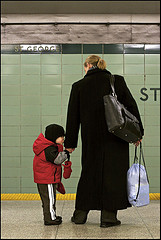The latest issue of the New York Times Magazine has a cover story titled “When Mom and Dad Share It All” about the division of labor in American families and how childcare and housework are balanced by working mothers and fathers.
This article notes recent findings from Wisconsin’s National Survey of Families and features commentary from University of Buffalo sociologist, Sampson Lee Blair.
Social scientists know in remarkable detail what goes on in the average American home. And they have calculated with great precision how little has changed in the roles of men and women. Any way you measure it, they say, women do about twice as much around the house as men.
The most recent figures from the University of Wisconsin’s National Survey of Families and Households show that the average wife does 31 hours of housework a week while the average husband does 14 — a ratio of slightly more than two to one. If you break out couples in which wives stay home and husbands are the sole earners, the number of hours goes up for women, to 38 hours of housework a week, and down a bit for men, to 12, a ratio of more than three to one. That makes sense, because the couple have defined home as one partner’s work.
But then break out the couples in which both husband and wife have full-time paying jobs. There, the wife does 28 hours of housework and the husband, 16. Just shy of two to one, which makes no sense at all.
The lopsided ratio holds true however you construct and deconstruct a family. “Working class, middle class, upper class, it stays at two to one,” says Sampson Lee Blair, an associate professor of sociology at the University at Buffalo who studies the division of labor in families.
“And the most sadly comic data is from my own research,” he adds, which show that in married couples “where she has a job and he doesn’t, and where you would anticipate a complete reversal, even then you find the wife doing the majority of the housework.” — New York Times Magazine

 A
A 

 MercuryNews.com
MercuryNews.com